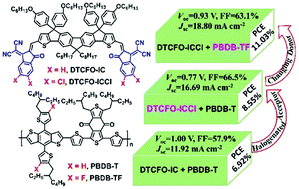Balancing photovoltaic parameters to enhance device performance of fluorene-fused heptacyclic small-molecule acceptors through varying terminal groups and polymer donors†
Abstract
Balancing photovoltaic parameters is very challenging to optimize the device performance of nonfullerene small-molecule acceptor (SMA)-based polymer solar cells (PSCs). We herein employed electron-withdrawing fluorinated or chlorinated 1,1-dicyanomethylene-3-indanone (ICF or ICCl) as the terminal acceptor (A) group to develop two acceptor–donor–acceptor (A–D–A) SMAs, DTCFO-ICF and DTCFO-ICCl, with an electron-rich fluorene-fused dithienocyclopentafluorene as the identical central donor (D) core. Compared with the nonhalogenated counterpart (DTCFO-IC), the two halogenated SMAs possessed a red-shifted absorption spectrum, reduced optical bandgap, and increased charge carrier mobility, but these were accompanied by down-shifted HOMO and LUMO levels, especially for the chlorinated molecule (DTCFO-ICCl). Accordingly, with respect to DTCFO-IC, PSCs based on the two halogenated SMAs with polymer PBDB-T as a donor exhibited an improved Jsc, but a dropped Voc, thus leading to a commensurate power conversion efficiency (PCE) of 6.80% for DTCFO-ICF and an increased PCE of 8.55% for DTCFO-ICCl. To further improve the device performance by means of balancing photovoltaic parameters, polymer PBDB-TF with a lower-lying HOMO level relative to PBDB-T was used to replace PBDB-T as the donor. The PCEs of PBDB-TF-based PSCs were further improved mainly due to the significantly enhanced Voc. Importantly, the DTCFO-ICCl-based PSCs achieved a high PCE of up to 11.03% along with an increased Voc (0.93 V), a further increased Jsc (18.80 mA cm−2), and almost retained FF (63.1%). The enhanced device performance could be attributed to better charge transport and collection abilities, less charge recombination and more optimal active layer morphology. These results argue that combining the halogenation on the A group of an A–D–A acceptor and variation of the paired polymer donor could be an effective strategy to enhance the device efficiency by balancing photovoltaic parameters.



 Please wait while we load your content...
Please wait while we load your content...